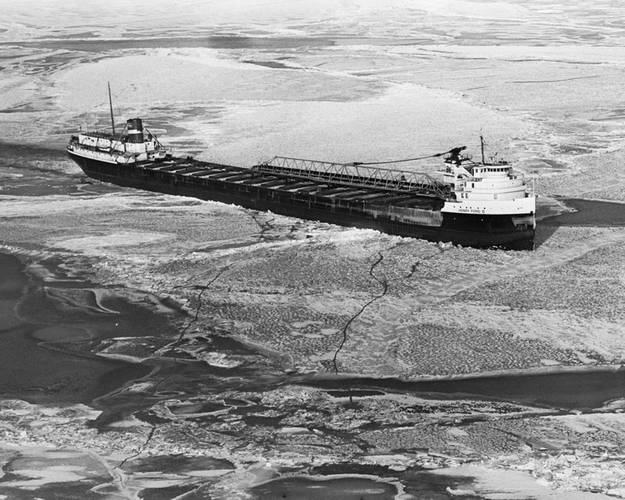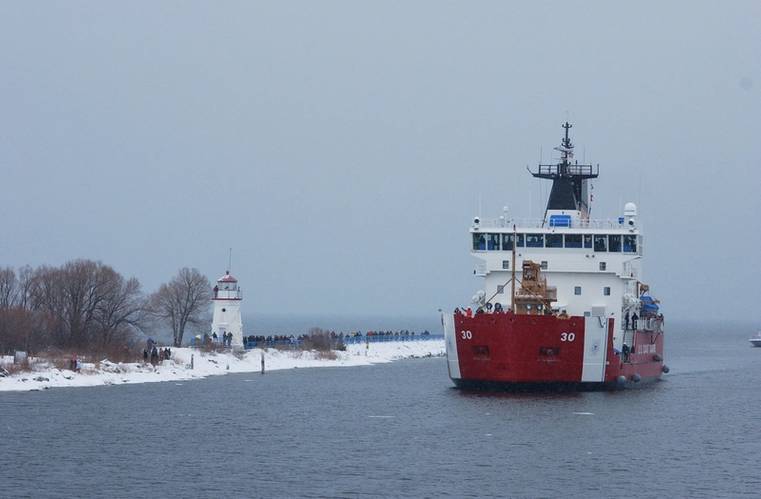Too few icebreakers and lack of a second Poe-sized lock threaten shipping on the Great Lakes and St. Lawrence Seaway
Insufficient U.S. and Canadian icebreakers and reliance on a single Poe-sized lock to connect Lake Superior to the Lower Lakes and Seaway threaten the future of shipping on America’s Fourth Sea Coast warns Great Lakes Maritime Task Force (GLMTF) in its 2015 Annual Report released today.
“Another near arctic winter significantly impacted navigation, and then a 20-day closure of the MacArthur Lock in late summer gave us an uninviting preview of the delays and disruptions that will come should a mechanical or structural issue incapacitate the Poe Lock for a lengthy period of time. If unaddressed, neither augers well for the future of Lakes/Seaway shipping,” the report said.
The ice on the Lakes in 2015 was formidable, notes the Lake Carriers’ Association (LCA). A 767-foot-long U.S.-flag laker with an ice-strengthened bow and 7,000-horsepower engine packed in her hull sat immobile in Lake Erie, within sight of land, for five days in February. A U.S. Coast Guard icebreaker was unable to free the Arthur M. Anderson. A Canadian Coast Guard icebreaker eventually broke the vessel out, but the ship’s last cargo had to be cancelled.
Conditions had not eased when the Soo Locks opened on March 25 and within four days the Mackinaw the U.S. Coast Guard’s newest and most powerful icebreaker, had suffered a casualty to its propulsion system and was unable to operate at full strength for the remainder of the spring breakout.
GLMTF, the largest labor/management coalition ever assembled to promote Lakes/Seaway shipping, hailed the Coast Guard Authorization Act of 2015 (signed by President Obama this month) for the provision authored by Congresswoman Candice Miller (R-Mich.) that authorizes construction of a new heavy icebreaker for the Lakes and will now focus its attention on having Congress appropriate the funds to build the vessel. Its cost is estimated at approximately $200 million.
The Task Force also urged the Coast Guard to accelerate the modernization of the 140-foot-long icebreakers stationed on the Lakes. The vessels were built between 1979 and 1987 and are in need of extensive upgrading. GLMTF asked that the work be moved from the Coast Guard yard in Baltimore to Great Lakes shipyards.
GLMTF’s 2015 Annual Report also warns that last summer’s 20-day closure of the MacArthur Lock highlights the need to create redundancy at the locks at Sault Ste. Marie, Michigan, by twinning the Poe Lock. “The MacArthur Lock is 73 years old, the Poe Lock, 47. At least in this instance, vessels that normally transit the MacArthur Lock can use the Poe Lock, so cargo was delayed rather than cancelled. Poe-class vessels are too big to go through the MacArthur Lock, and they represent 70 percent of U.S.-flag carrying capacity on the Lakes. A lengthy closure of the Poe Lock would slow trade to a trickle at best.”
Although authorized by Congress at full Federal expense, a second Poe-sized lock has been stalled by a flawed analysis of the benefit/cost ratio. “Fortunately, that flawed analysis is going to be reviewed, in part because a Department of Homeland Security report forecasts catastrophic and nationwide impacts if the Poe Lock is incapacitated. The Corps has reprogrammed $1.35 million for the re-evaluation and allotted 24 months for completion. We urge the Corps to complete the new analysis in not more than 18 months.”
The Task Force reported major progress on the dredging crisis. “The Corps was able to dredge 21 ports and waterways and remove 3.1 million cubic yards of sediment. The Corps’ workplan for 2016 calls for dredging 25 projects and removing 3.4 million cubic yards.”
GLMTF continued to support S. 373, the Vessel Incidental Discharge Act, as it would establish a uniform, federal ballast water standard.
The Task Force concluded its report by calling for fair trade in steel imports. “We believe in ‘May the best man win,’ but dumping steel into the U.S. market has cost the Lakes jobs and cargo. Trade in any commodity must be free but fair.”















